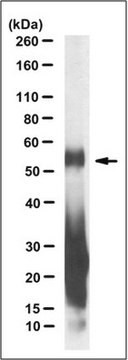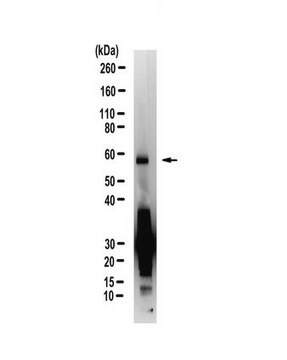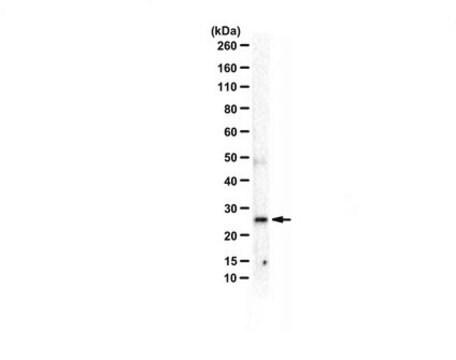ABN1356
Anti-C9ORF72/C9RANT (poly-PA)
serum, from rabbit
Synonym(s):
C9ORF72/C9RANT (poly-PA), alpha-PA-antisense
About This Item
Recommended Products
biological source
rabbit
Quality Level
antibody form
serum
antibody product type
primary antibodies
clone
polyclonal
species reactivity
human
technique(s)
dot blot: suitable
immunofluorescence: suitable
immunohistochemistry: suitable
western blot: suitable
NCBI accession no.
UniProt accession no.
shipped in
ambient
target post-translational modification
unmodified
Gene Information
human ... C9orf72(203228)
General description
Specificity
Immunogen
Application
Immunofluorescence Analysis: A 1:500 dilution from a representative lot detected C9ORF72/C9RANT (poly-PA) in Flag-PA trannsfected HEK293T cells (Courtesy of Dr. Laura P.W. Ranum and Dr. Lien Nguyen from the University of Florida).
Western Blotting Analysis: A representative lot detected C9ORF72/C9RANT (poly-PA) in recombinant Protein (Zu, T., et. al. (2013). Proc. Natl. Acad. Sci. USA. 110(51):E4968-77).
Immunohistochemistry Analysis: A representative lot detected C9ORF72/C9RANT (poly-PA) in aggregates found in neurons of the CA and DG regions of the hippocampus (Zu, T., et. al. (2013). Proc. Natl. Acad. Sci. USA. 110(51):E4968-77).
Dot Blotting Analysis: A representative lot detected C9ORF72/C9RANT (PR-CT) in Dot Blotting applications (Zu, T., et. al. (2013). Proc Natl Acad Sci USA. 110(51):E4968-77).
Neuroscience
Quality
Western Blotting Analysis: A 1:1,000 dilution of this antibody detected C9ORF72/C9RANT (poly-PA) in 10 µL of lysate from HEK293 cells transfected with Flag-PA.
Target description
Physical form
Storage and Stability
Handling Recommendations: Upon receipt and prior to removing the cap, centrifuge the vial and gently mix the solution. Aliquot into microcentrifuge tubes and store at -20°C. Avoid repeated freeze/thaw cycles, which may damage IgG and affect product performance.
Other Notes
Disclaimer
Not finding the right product?
Try our Product Selector Tool.
Storage Class
12 - Non Combustible Liquids
wgk_germany
WGK 1
Certificates of Analysis (COA)
Search for Certificates of Analysis (COA) by entering the products Lot/Batch Number. Lot and Batch Numbers can be found on a product’s label following the words ‘Lot’ or ‘Batch’.
Already Own This Product?
Find documentation for the products that you have recently purchased in the Document Library.
Our team of scientists has experience in all areas of research including Life Science, Material Science, Chemical Synthesis, Chromatography, Analytical and many others.
Contact Technical Service








